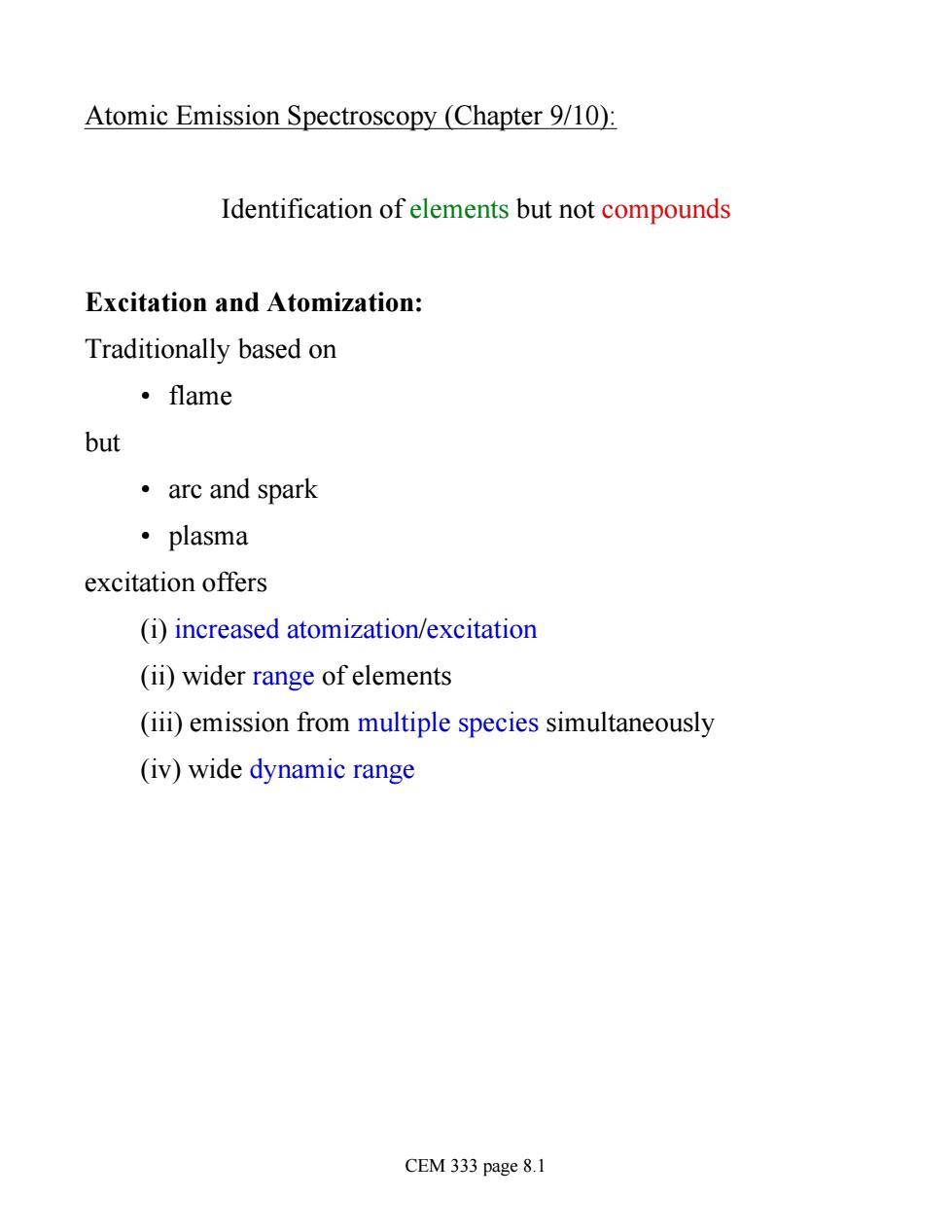
Atomic Emission Spectroscopy (Chapter 9/10): Identification of elements but not compounds Excitation and Atomization: Traditionally based on ·flame but ·arc and spark ·plasma excitation offers (i)increased atomization/excitation (ii)wider range of elements (iii)emission from multiple species simultaneously (iv)wide dynamic range CEM 333 page 8.1
Atomic Emission Spectroscopy (Chapter 9/10): Identification of elements but not compounds Excitation and Atomization: Traditionally based on • flame but • arc and spark • plasma excitation offers (i) increased atomization/excitation (ii) wider range of elements (iii) emission from multiple species simultaneously (iv) wide dynamic range CEM 333 page 8.1

Flame Excitation Sources: 700 5.0 1750 600 1800 1400 1830 1858 30 1830 800 700 1.51.00.500.51.015 em Burner tip cm (Fig9-3) Primary Combustion Zone Interzonal Region Secondary Combustion Zone Flame Temperatures: Fuel Oxidant Temperature Gas Air ~1800C H2 02 ~2600C Acetylene 02 ~3000C CEM 333 page 8.2
Flame Excitation Sources: (Fig 9-3) Primary Combustion Zone Interzonal Region Secondary Combustion Zone Flame Temperatures: Fuel Oxidant Temperature Gas Air ~1800 °C H2 O2 ~2600 °C Acetylene O2 ~3000 °C CEM 333 page 8.2

Laminar Flow Burner:(Fig 9-5) ner head ocking ring Auxiliar oxidant relief vents Flow spoile (Panton plastic) To waste Nebulizer ·Cheap ·Simple ·Flame stability ·Low temperature CEM 333 page 8.3
Laminar Flow Burner: (Fig 9-5) • Cheap • Simple • Flame stability • Low temperature CEM 333 page 8.3

Arc and Spark Excitation Sources: Limited to semiquantitative/qualitative analysis (arc flicker) Usually performed on solids Largely displaced by plasma-AES Electric current flowing between two C electrodes (Fig 10-16) Counter Electrodes for electrodes holding sample Sample pressed into electrode or mixed with Cu powder and pressed- briquetting Cyanogen bands(CN)350-420 nm occur with C electrodes in air- He,Ar atmosphere CEM 333 page 8.4
Arc and Spark Excitation Sources: • Limited to semiquantitative/qualitative analysis (arc flicker) • Usually performed on solids • Largely displaced by plasma-AES Electric current flowing between two C electrodes (Fig 10-16) Sample pressed into electrode or mixed with Cu powder and pressed - briquetting Cyanogen bands (CN) 350-420 nm occur with C electrodes in air - He, Ar atmosphere CEM 333 page 8.4

Arc/spark unstable-each line measured >20 s(needs multichannel detection) photographic film ·Cheap Long integration times Difficult to develop/analyze Non-linearity of line "darkness" wavclengths Grating A■Slit Lens Source Fig10-17 CEM 333 page 8.5
Arc/spark unstable - each line measured >20 s (needs multichannel detection) photographic film: • Cheap • Long integration times • Difficult to develop/analyze • Non-linearity of line "darkness" Fig 10-17 CEM 333 page 8.5